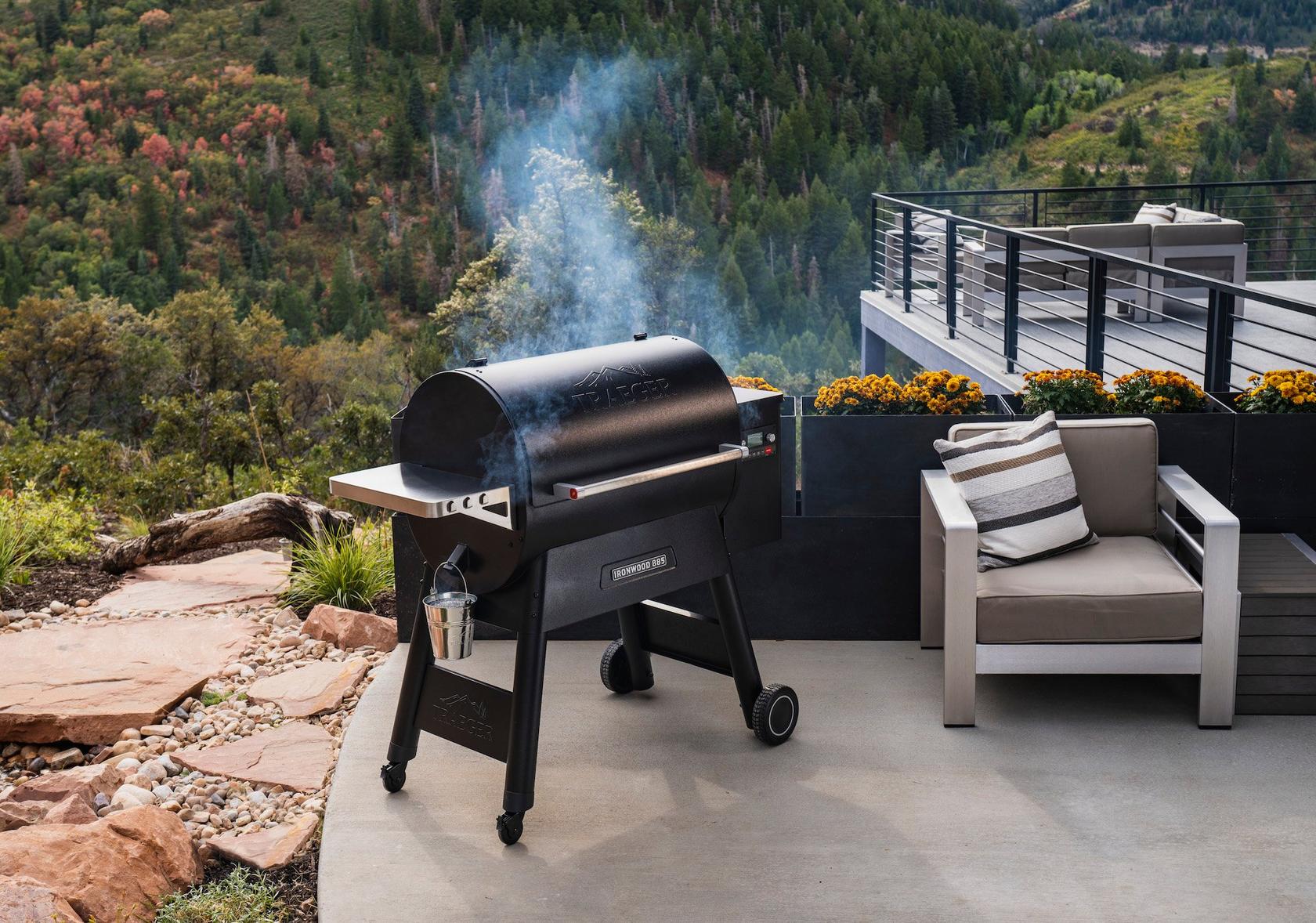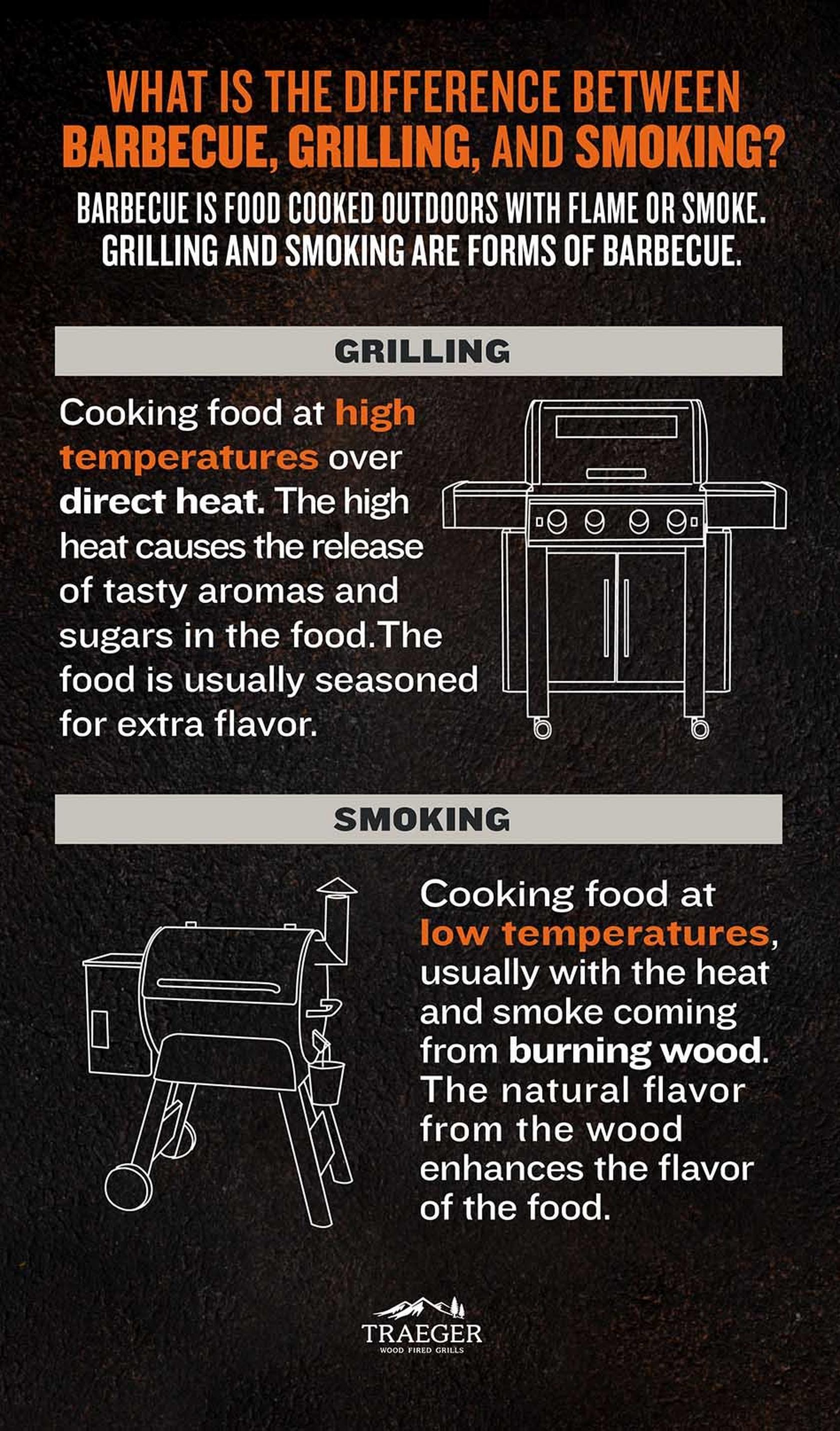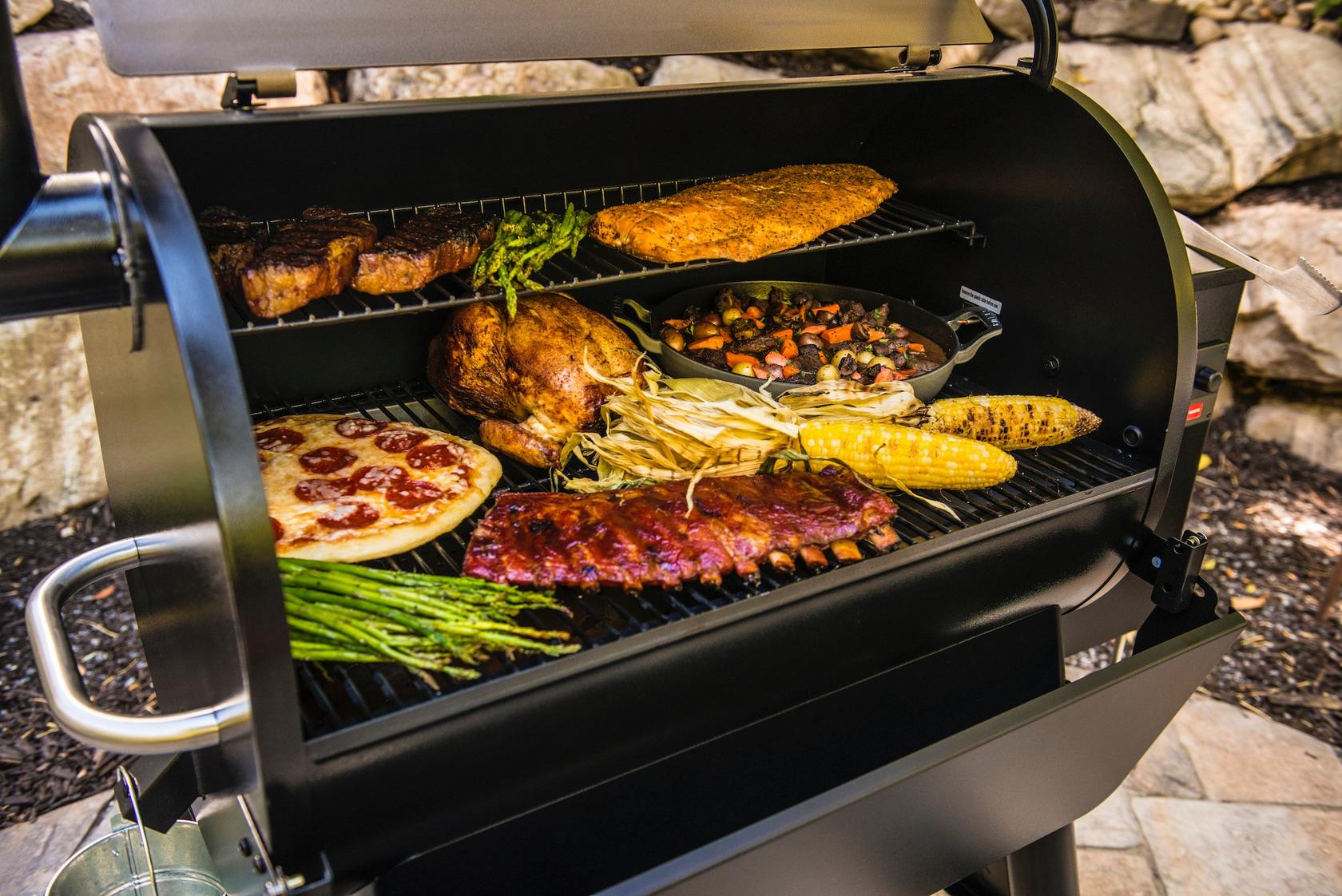
Your friend says she's going to cook outside with wood pellets, charcoal, or gas.
She might say she's going to smoke on the grill for a barbecue.
Or she's barbecuing on the grill for a smoke-out -- or simply that she's grilling. You'd probably understand what she meant, but it is a little confusing because "barbecue," "grilling," and "smoking" have overlapping meanings.
- Barbecuing, grilling, and smoking can all refer to the process of cooking outside.
- Barbecue, grill, and smoker can also refer to the appliance used to do the cooking.
- A barbecue or smoke-out are sometimes used to describe the event where the cooking (and eating) is to take place.
We're going to dig into the mystery of these three words. We'll see where they came from and how barbecue/grilling/smoking experts use them today.

According to Merriam-Webster, the word "barbecue" derives from the Spanish word "barbacòa." Barbacòa itself may derive from a similar sounding word used by the Taino, indigenous people of the Caribbean.
Barbacòa, first used in the 1500s, refers to a frame of wood on which raw meat was supported, and then cooked over open flame. So the word “barbecue" originally referred to what we might call a cooking appliance.
Within a few generations, the term began to have other meanings. "Barbecue" was used to mean the method of cooking over open flame as early as the 1600s. And by the 1700s, it had come to mean a social event, especially in America. For evidence, [take this 1769 entry from future President George Washington's diary] "Went up to Alexandria to a barbecue and stayed all night."
According to Merriam-Webster, the word "barbecue" derives from the Spanish word "barbacòa." Barbacòa itself may derive from a similar sounding word used by the Taino, indigenous people of the Caribbean.
Barbacòa, first used in the 1500s, refers to a frame of wood on which raw meat was supported, and then cooked over open flame. So the word “barbecue" originally referred to what we might call a cooking appliance.
Within a few generations, the term began to have other meanings. "Barbecue" was used to mean the method of cooking over open flame as early as the 1600s. And by the 1700s, it had come to mean a social event, especially in America. For evidence, [take this 1769 entry from future President George Washington's diary]"Went up to Alexandria to a barbecue and stayed all night."

The Origins of "Barbecue"
According to Merriam-Webster, the word "barbecue" derives from the Spanish word "barbacòa." Barbacòa itself may derive from a similar sounding word used by the Taino, indigenous people of the Caribbean.
Barbacòa, first used in the 1500s, refers to a frame of wood on which raw meat was supported, and then cooked over open flame. So the word “barbecue" originally referred to what we might call a cooking appliance.
Within a few generations, the term began to have other meanings. "Barbecue" was used to mean the method of cooking over open flame as early as the 1600s. And by the 1700s, it had come to mean a social event, especially in America. For evidence, [take this 1769 entry from future President George Washington's diary] "Went up to Alexandria to a barbecue and stayed all night."
The Origins of "Grilling"
"Grilling" derives from the French word "grille" which refers to any type of decorative metal grating in a gridiron pattern.
A similar pattern is found on iron grates that were placed over open flame for meats to be cooked. We first see the word "grilling" being used in this sense in the 1600s according to the Oxford English Dictionary. And it's still used this way today.

The Origins of "Smoking"
The word "smoke" when referring to the visible byproduct of fire, is one of the oldest words in the English language. We say it pretty much the same way as Old English speakers did 1,000 years ago. Use of "smoking" to refer to a method of cooking food seems to be an American English innovation. We turn once again to that accomplished Founding Father, George Washington: "I have directed the provision ... to be smoked, if there are conveniences for doing it" Washington wrote in a 1757 letter.
In Washington's time, large quantities of meat were smoked and dried as a means of preservation. You can visit Washington's smokehouse at Mount Vernon today.
Barbecue, Grilling, and Smoking Today
When we talk about barbecue, grilling, and smoking now, we're usually talking about cooking food outdoors with some sort of flame or combustion as the heat source. All three terms fall along a spectrum of outdoor cooking.
What Is Barbecue?
As it's used today, the word "barbecue" is an overarching term. You might talk about barbecuing steak, or barbecuing brisket. Even though these are very different cooking processes (steak takes ten minutes and brisket takes ten hours) most people would know what you're talking about.
Some purists insist the word "barbecue" should only be used when talking about slow cooking over open flame. This is the original sense of the word, but modern usage has turned "barbecue" into more of a category. It's perfectly normal to use the word that way.
"Barbecue" now also refers to a type of flavor found in barbecue sauces and dry rubs. Smoky, spicy, savory, and a little bit sweet, barbecue flavor is now found in potato chips, beef jerky, and other manufactured foods.
The flavor that has come to be known as barbecue is most reminiscent of Kansas City style sauces made with ketchup, which started becoming popular early in the 1900s. When people talk about barbecue sauce, this is usually the type they mean. But there are many other barbecue sauces and flavors.
And, as it has since the 1500s, barbecue can also refer to the cooking apparatus used to smoke or grill meat. The original barbecue was just a structure of sticks suspending meat over an open flame -- something that would be easy enough to DIY if you had the right materials.
But most people barbecue on a manufactured appliance of some sort. These can be broadly characterized as grills or smokers, though there are some products, like wood pellet grills, that are equally good for grilling and smoking.
What Is Grilling?
"Grilling" is in a specific place on the outdoor cooking spectrum. As mentioned above, the name derives from the iron grates used to sear food over open flames.
So, when you talk about grilling you should only be talking about cooking for short periods of time over high heat -- the way most people cook burgers, for example. You typically won't hear barbecue experts talking about grilling ribs or grilling brisket, because larger cuts of meat like these can't be fully cooked over high heat.
How to Grill
When you grill, the flavor comes mainly from the seasoning you put on the meat or vegetables. Meats like steak, which already have lots of flavor, may only need a little bit of salt and pepper. For lighter-flavored meats like chicken or pork, most grillmasters like to apply a dry rub, or marinate the meat, to give it extra flavor.
Likewise, with vegetables, a fresh ear of summer sweet corn can be seasoned simply. But a vegetable with less natural flavor, like zucchini, can sometimes benefit from a dash of herbs or spices before going on the grill.
Indirect Grilling
You'll sometimes hear the term "indirect grilling." Indirect grilling is really just setting up your grill to be a smoker. You divide your grill into two areas: One area where the heating happens (from charcoal briquettes or gas burners), and another area where the food sits. Indirect grilling is used to cook meats (like pork shoulder, whole chicken, and brisket) that would burn before cooking all the way through if you put them directly over heat.
Even though brisket can be cooked this way on a grill, a barbecue expert would not refer to this as "grilling" brisket.
A Traeger wood pellet grill is automatically set up for indirect heating, because it doesn't have an open flame. You can use the entire surface of the grill to cook low and slow.
Types of Grills
Grills come in all shapes and sizes. The Japanese charcoal grill known as a hibachi is sold in sizes as small as four inches across. Large gas grills can be several feet wide. You can find grills that are box-shaped, kettle-shaped, and egg-shaped.
The three main types are charcoal grills that use charcoal as a fuel source, gas grills which use natural gas as a fuel source, and wood pellet grills which use wood pellets as a fuel source.
There are also gas and electric appliances sold as grills and use infrared heat to cook food. Infrared heat comes via material like metal, glass or ceramic which is itself heated by gas or electricity. The panel of material heats up -- more evenly and often hotter than gas or charcoal alone would -- and the heat from the material cooks your food.
Grilling vs. Broiling
You may sometimes hear grilling compared to broiling. These are both methods of direct cooking. The food is placed directly below (or above) the heat. Most stoves come equipped with broilers so you can do high-temperature, direct cooking in your home kitchen.
What Is Smoking?
"Smoking" is on the other end of the outdoor cooking spectrum, and refers to low and slow cooking over indirect heat. The food gets cooked by a heat source that isn't directly beneath it.
Smoke that is generated during the cooking process — from wood pellets, wood chips/chunks, or from a full-on wood fire — flavors the meat while it cooks. There are many different ways to smoke, but low heat and smoke flavor are the two non-negotiable parts of the process.
Smoking on gas or charcoal grills requires adding wood chips or chunks to the fire. Some manufactured smokers also require the use of chips, while others are built to accommodate a wood-only fire. When smoking on a wood pellet grill, the pellets generate the heat and the natural smoke that flavors the food.
Hot Smoking vs. Cold Smoking
There are two main types of smoking, hot smoking and cold smoking. Hot smoking is the process used by famous barbecue restaurants on foods like ribs and brisket, in the majority of barbecue competitions, and by home cooks. Hot smoking involves delivering smoke and heat — approximately 225 degrees Fahrenheit or above — to slowly cook large cuts of meat while infusing them with natural smoke flavor.
So, what is cold smoking? Cold smoking is not exactly cold, but it does require much cooler temperatures than hot smoking. When you cold smoke, you may be working with foods that are already cooked, like cheese or soy sauce. The goal is to infuse the products with the smoke flavor, rather than cook them. When cold-smoking, you'll be keeping the temperature inside your smoker very low at less than 100 degrees Fahrenheit.
Smoker vs. Grill
What's the difference between a smoker and a grill? A smoker cooks food at low temperatures, by burning wood, to create tender wood-fired meat. A grill cooks food at high temperatures over direct heat.
Whether It's Barbecue, Grilling, or Smoking, a Traeger Can Do It
At Traeger, we've developed one product that can cover the entire spectrum of barbecue. You can turn your Traeger up as high as 500 degrees for direct-heat grilling, or you can use our smoking function to keep the heat low and allow the natural flavor of wood pellets to enhance your food.
Most charcoal and gas grills are good for grilling, but not so good at smoking. Smokers, as the name suggests, are designed for smoking. They aren't as good at grilling. Wood pellet grills, like the ones we make at Traeger, are excellent at both forms of barbecue, grilling, and smoking.